
Pina Bausch
(1940-2009)
An iconic
choreographer-dancer, in love with India
- Rajika Puri,
NYC
e-mail: rajikapuri@yahoo.com
July 7, 2009
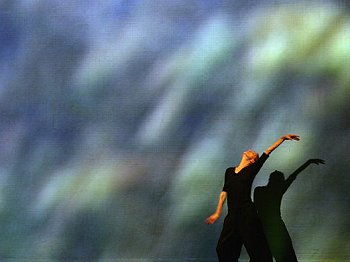 Pina Bausch
in a rare appearance in one of her pieces: Danzon ('95) © Jochen Viehoff
Pina Bausch
in a rare appearance in one of her pieces: Danzon ('95) © Jochen Viehoff
|
On the day that
Bamboo Blues, Pina Bausch's dance-theatre work inspired by India, premiered
in Delhi in 2008, this luminous woman, arguably the most influential choreographer
and theater artist of our time, gave one of her rare interviews.
"It's impossible for us to do a piece about India," she said. "Impossible.
What do we know about India? . . . There is so much to learn."
Yet she had
found inside herself a deep respect and love for this country, nurtured
by friendships with Indians in India and abroad which finally led her to
bring members of her company Tanztheater Wuppertal to India for a residency.
Then, approaching the prospective work in the way she developed most of
her dance-theatre pieces, she asked them questions of what they had seen,
smelt, felt, and helped shape their answers into modules of movement.
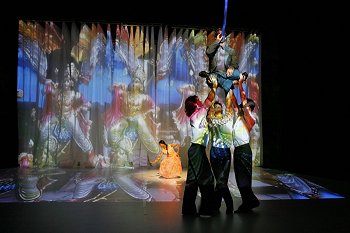 'Bamboo
Dreams': Ganesh being carried while Shantala Shivalingappa performs an
adavu
Photo:
Richard Termine, Courtesy: BAM
'Bamboo
Dreams': Ganesh being carried while Shantala Shivalingappa performs an
adavu
Photo:
Richard Termine, Courtesy: BAM
|
By 2006, Ms Bausch
had reached iconic status - not just in her native Germany and the west,
but around the world. Her company performed her extensive repertoire of
about forty-four works in cities that ranged from Sao Paolo and Santiago
de Chile to Budapest, Cairo, and Seoul. Her interest in other cultures
dates from the early 'eighties, since when she made works inspired by different
places like Hong Kong, Portugal, Argentina, and Japan.
But India had
a special place in her heart.
Ms Bausch's
connection with India goes back to '79 when she toured Fruehlingsopfer
('Rite of Spring'). This '75 work is an emotionally charged, visceral interpretation
of Igor Stravinsky's music envisioning a primitive human sacrificial rite.
Performed on a layer of earth, it involves nudity, which caused a youth
group in Calcutta to stop the show. But in those days Ms Bausch was used
to controversy and resistance because she always asked uncomfortable questions,
dealt with things that made us squirm, pushed the envelope so to say.
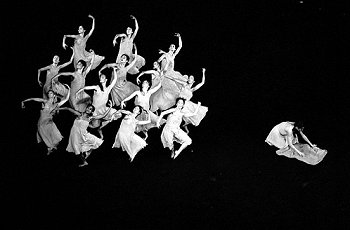 'Rite
of Spring' ('75) toured in India in 1979 © Jochen Viehoff
'Rite
of Spring' ('75) toured in India in 1979 © Jochen Viehoff
|
She returned a
year later, just to visit, and went into remote parts of Kerala, attending
all-night performances in temple precincts, drawn by a spiritual connection
that this very private person rarely talked about. Over the years she made
friends with Indian dancers like the Paris-based Savitry Nair (a Kalakshetra
student, also shishya of Guru Vempati Chinna Satyam) and Chandralekha,
through whom she imbibed much about India and Indian dance.
By the time
Tanztheater Wuppertal returned to India in '94, her friendship with Chandralekha
had cemented to the point that 'Nelken' or 'Carnations' ('84) was co-presented
on tour in India with Chandralekha's 'Yantra.' Catching them at performances
in Mumbai, I was struck by the easy comfort of their friendship. Both had
giant intellects which were translated into deeply moving theatrical works
of intense beauty. Both challenged us to re-think not just 'dance' but
the very essence of being human.
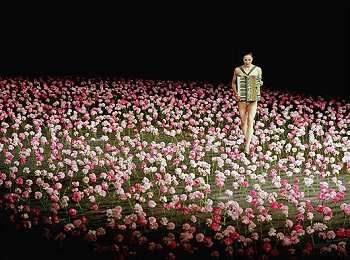 Field
of carnations in 'Nelken' ('84) on tour in India with Chandralekha's 'Yantra'
© Jochen Viehoff
Field
of carnations in 'Nelken' ('84) on tour in India with Chandralekha's 'Yantra'
© Jochen Viehoff
|
As the curtain
went up at Homi Bhaba Auditorium in Mumbai, I'll never forget the gasp
from the audience as we saw the stage filled shin-high with (plastic) carnation
plants. Later, there were many discussions in the lobby because the dancers
had often spoken to us directly - even defiantly. "Is this dance or is
this theatre?" some asked. And that is precisely the point. What Ms Bausch
called it was 'dance-theater,' and by '84 she had developed the format
followed by most of her subsequent works - powerful movement solos interspersed
with theatrical vignettes in which the dancers speak - and interact - with
the audience.
Ms Bausch's
love of Indian dance found greater expression in her own work after she
invited Savitry Nair's daughter Shantala Shivalingappa, a Kuchipudi dancer,
to become Guest Artist with Tanztheater Wuppertal in '99. Shantala first
performed in 'O Dido' and was incorporated into the older Fruehlingsopfer
- both essential 'western' works - but in 'Nefes' ('03) she danced not
only modern western movements but also excerpts from her traditional Kuchipudi
vocabulary. Then came Ms Bausch's 'India piece.'
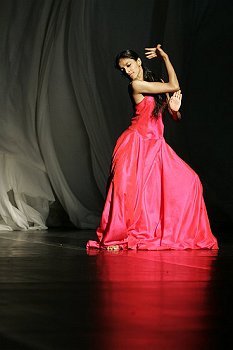 Shantala
Shivalingappa playing with mudra © Jochen Viehoff
Shantala
Shivalingappa playing with mudra © Jochen Viehoff
|
'Bamboo Blues'
is filled with vignettes inspired by their travels in India. Scenes that
stand out: a fashion show catwalk of paired dancers in variously draped
Malayali mundus, a woman washing her hair in a bright red plastic bucket,
a group of reclining women chewing something who were variously interpreted
as 'bored courtesans surveying prospective clients,' 'a National Geographic
photo of a group of tigers,' and (this one I believe was correct) 'an assemblage
of cows, chewing cud'!
 'Bamboo
Dreams': 'reclining cows chewing cud' © Jochen Viehoff
'Bamboo
Dreams': 'reclining cows chewing cud' © Jochen Viehoff
|
These kinds of
images, however, are interspersed with beautiful dance solos - a woman
twirling and twisting across the stage creating patterns with her flowing
dress and her long black hair, a group of men in black trousers and white
shirts writhing sinuously on the floor only to jump up and do a Shahrukh
Khan take-off, Shantala Shivalingappa involved in a contemplation of the
movements of her hastamudra, which pull her in unexpected directions.
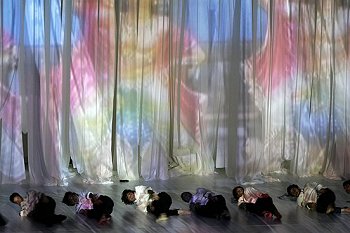 'Bamboo
Dreams': men writhing on ground against Bollywood projections © Jochen
Viehoff
'Bamboo
Dreams': men writhing on ground against Bollywood projections © Jochen
Viehoff
|
 'Bamboo
Blues' - men in mundus flinging veshtis by Jochen Viehoff
'Bamboo
Blues' - men in mundus flinging veshtis by Jochen Viehoff
|
On June 12, Ms
Bausch's newest work - still only titled 'New Piece 2009' (Neuest Stucke
2009) - had its first performance at her company's home in Wuppertal. I
had heard that Joseph Melillo, Executive Producer at New York's Brooklyn
Academy of Music (BAM), was flying over to see it, and looked forward to
seeing it soon in New York (since 1984, BAM has presented 19 of her 44
works). No doubt we still will - but without Ms Bausch there to grace its
New York premiere.
A last image
provided by him offers much solace:
"My final
vision of Pina is at the post-premiere party surrounded by her dancers,
former dancers, colleagues from around the globe including myself, friends
and local supporters. The new and now final work of art was a beautiful
creation. The dancers were stunning. Pina was very, very happy."
Rajika
Puri is an acclaimed exponent of Bharatanatyam (Sikkil Guru Ramaswamy Pillai)
and Odissi (Deba Prasad Das), which she performs in solo recitals all over
Europe, the US, Latin America, and India. Rajika has also studied western
music (the voice and piano), American Modern Dance (at the Graham &
Cunningham studios in New York), and Flamenco. Career highlights include
a command performance for the President of Mexico. She has had a unique
career on the western stage, often bringing to her roles the richness of
the Indian theatre tradition she was initially trained in. In 1983 she
received an MA in The Anthropology of Human Movement from New York University,
specializing in how meaning is made through movements such as the hand
gesture (hasta mudra) system of classical Indian theatre. Writings and
articles range from academic papers in journals like Semiotica to previews
of dance performances in Playbill, and magazine features on dance from
a cultural perspective.. |





